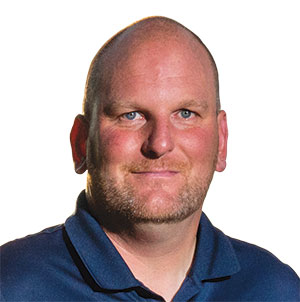Peak maintenance in golf course management

Alan FitzGerald (Photo: Fernando Gaglianese)
Looking back over the last 150 years, it’s amazing to see how far humanity has come since the start of the Industrial Revolution, from transportation innovations of the 20th century that shrunk the planet, to space travel and the computer age.
However, even considering those advancements, it feels like nothing major has happened since Al Gore invented the internet in the ’90s, except for the rise of social media, which easily is dismissed as the way we live rather than an invention.
Other than purchasing my Christmas list from my couch, it feels like there have been no major leaps since we left the moon and found the Titanic. After humans reached those lofty goals, we peaked. We now seem to be honing past achievements by making things better, more efficient and cheaper. The world, though, has become more conscious of the environment, which now is driving the latest big changes, whether you believe in climate change or not. You know change is coming when Ford launches an electric Mustang SUV!
But this got me thinking. How does all this compare to advances in golf course management?
Our industry has advanced along with the world, going from horse-drawn mowers and dragging hoses late at night with a six-pack of Old Milwaukee, to the nearly six-figure hybrid fairway mowers and irrigation systems we control from anywhere with a Wi-Fi or cell signal.
But what about turf? Have we reached the peak of maintaining turf in traditional ways? Everything we do today has its origins in Old Tom Morris’ practices in Scotland more than 100 years ago, honed to the perfect conditions required today by our employers/members/customers.
We currently are reaching peak greenkeeping in the traditional sense, where we attain standards solely by human input. How much faster can greens get? I’m sure some superintendents in the early ’80s laughed and said, “Ha! We’ve peaked, there’s no way daily speeds will go over 11 feet!” Yet here we are.
The level of maintenance today is in another league from 30 years ago. While there is potential for greens to get faster, will it be fair? We are reaching the maximum potential of what we can achieve within the resource limitations currently available to us and golf courses.
So, have we peaked? Are we reaching the upper limits of perfection? The human drive to deliver a better product has delivered progress, and we are looking to technology to advance what we can do. Over the last 10 years, the amount of tech — including moisture meters and drones — has increased exponentially. Are we reaching the peak of traditional greenkeeping and starting the switch to where the human element will be reduced in turf management?
For daily operations, robots can take care of mundane tasks like hand-mowing greens with a cold precision never achieved by the best humans, let alone a half-asleep, hungover human at 6 a.m. The machines will need some supervision but will overall free up labor for more detailed tasks, which will probably net the biggest gains, assuming staffing levels are not curtailed too much because of the robotic mower.
However, computers lack critical thinking, especially when dealing with an uncontrollable factor such as Mother Nature, so the need for human interpretation still will be essential. The information stream available to the superintendent will help him or her make better decisions and ensure the best use of resources, which ultimately will benefit the environment and the bottom line.
Thirty years from now, turf managers will read this and wonder why staff were walking off hangovers at 6 a.m. and will be amazed at how their fairways are cut at 2020 greens height, the quaint green speeds of only 12 feet and why Old Milwaukee was ever needed to water anything. Maybe we have not reached peak greenkeeping after all.
Alan FitzGerald (alan@ledgerockgolf.com) is superintendent at Ledgerock GC in Mohnton, Pa. This is his debut column with Golfdom.












It is always refreshing when someone takes pause to wonder where we are relative to the past, and where we are going. Alan is correct that course playing conditions may have peaked as the cost of going further, whether technology allows or not, is quickly becoming prohibitive for the majority of golfers who play the game. Unless we can find ways to produce what we have with less cost, I don’t see us climbing any higher mountains. While everyone looks at labor and salaries as the culprit, this is not, in my opinion, the biggest challenge. How does a supplier industry survive by developing tools that do more with less, last longer without costing a fortune to maintain, and then sell at a cost that is both affordable and consistent with the price the average golfer can or is willing to pay? We are at a crossroads that I don’t believe we have seen before. One of my favorite takeaways from my time with PGA Tour Agronomy was from a senior Rules Official. I was lamenting that the course playing conditions were not going to meet Player expectations when he told me, “Jon, we can play golf on a parking lot. The Rules cover everything.” Sage advice and worth remembering.